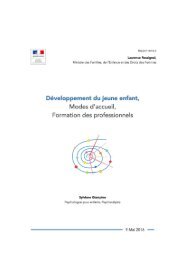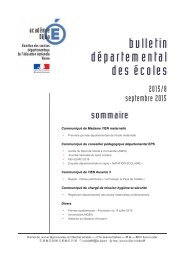agrl_innovations_in_ssa.pdf?utm_content=buffercb41d&utm_medium=social&utm_source=twitter
agrl_innovations_in_ssa.pdf?utm_content=buffercb41d&utm_medium=social&utm_source=twitter
agrl_innovations_in_ssa.pdf?utm_content=buffercb41d&utm_medium=social&utm_source=twitter
Create successful ePaper yourself
Turn your PDF publications into a flip-book with our unique Google optimized e-Paper software.
ZNFU realised the necessity for commercial viability by l<strong>in</strong>k<strong>in</strong>g farmers with markets,<br />
reduc<strong>in</strong>g transport costs and improv<strong>in</strong>g extension to ensure that CA was a viable<br />
proposition. At the same time, the Golden Valley Agricultural Trust (GART), a jo<strong>in</strong>t venture<br />
between Government, the ZNFU and University of Zambia was undertak<strong>in</strong>g research to<br />
validate and improve CA practices. A National Conservation Agriculture Associationof<br />
Zambia (CAAZ) was recently formed to l<strong>in</strong>k stakeholders and support MoA&C <strong>in</strong>itiatives<br />
to further scale up CA. Two complimentary programmes, a Conservation Agriculture<br />
Scal<strong>in</strong>g up Programme (CASPP) and a Farmer Suggested Initiative and Response<br />
Programme (FSIRP) are be<strong>in</strong>g established with a TF established to consider policy<br />
issues <strong>in</strong>clud<strong>in</strong>g subsidies, possible use of electronic vouchers for <strong>in</strong>put acquisition,<br />
and greater participation of the private sector. CA stakeholder groups have emerged at<br />
district, national and regional levels that are promot<strong>in</strong>g faster scal<strong>in</strong>g up of CA practices.<br />
Key lessons <strong>in</strong>clude the need to build strong partnerships, provide and susta<strong>in</strong><br />
tra<strong>in</strong><strong>in</strong>g and communication, ma<strong>in</strong>ta<strong>in</strong> research commitment and ensure the private<br />
sector becomes fully <strong>in</strong>volved <strong>in</strong> support<strong>in</strong>g <strong>in</strong>put and outputs markets to stimulate<br />
development.<br />
Initial context. Southern Africa is home to some of the most food-<strong>in</strong>secure communities <strong>in</strong><br />
the world. Agricultural productivity, not only <strong>in</strong> Zambia, but also <strong>in</strong> much of the sub-region,<br />
is low with average staple food crop yields lagg<strong>in</strong>g beh<strong>in</strong>d global levels. It was argued that<br />
conventional cultivation practices had contributed to decl<strong>in</strong><strong>in</strong>g productivity, <strong>in</strong>creas<strong>in</strong>g food<br />
<strong>in</strong>security, <strong>in</strong>creas<strong>in</strong>g poverty and serious soil degradation and desertification. There was<br />
clearly an urgent need to identify and promote more productive and more susta<strong>in</strong>able farm<strong>in</strong>g<br />
practices not only for maize but to promote diversification to other crops particularly legumes.<br />
The challenges. Until the 1950s, African farmers ma<strong>in</strong>ta<strong>in</strong>ed soil fertility primarily through<br />
shift<strong>in</strong>g cultivation, with natural fallows of 10–30 years rejuvenat<strong>in</strong>g soils between cultivation<br />
cycles. However, demographic pressure resulted <strong>in</strong> shortened fallow periods and expanded<br />
areas of permanent cultivation. In spite of effort to ma<strong>in</strong>ta<strong>in</strong> soil fertility, nutrient balances of<br />
African soils have decl<strong>in</strong>ed lead<strong>in</strong>g to grow<strong>in</strong>g concerns about agronomic and environmental<br />
susta<strong>in</strong>ability. In a region where up to 80 percent of the population derives their livelihoods<br />
from agriculture, decl<strong>in</strong><strong>in</strong>g soil fertility seriously constra<strong>in</strong>s efforts to raise farm productivity,<br />
<strong>in</strong>crease farm <strong>in</strong>comes and reduce poverty.<br />
Innovation triggers. Three decades of heavy subsidies on fertiliser and farm equipment ended <strong>in</strong><br />
the early 1990s. Cont<strong>in</strong>uous high-<strong>in</strong>put maize mono-cropp<strong>in</strong>g had left soils degraded, with high<br />
levels of soil erosion, acidity and compaction (ACT, 2011). It was <strong>in</strong>creas<strong>in</strong>gly realised that even <strong>in</strong><br />
years of good ra<strong>in</strong>fall the majority of smallholder farmers were food-<strong>in</strong>secure. Dur<strong>in</strong>g the 1990s a<br />
series of shocks <strong>in</strong>clud<strong>in</strong>g a series of drought years, decl<strong>in</strong>e <strong>in</strong> cattle numbers due to disease, and<br />
exchange rate devaluation contributed to soar<strong>in</strong>g fuel and fertiliser prices. This forced farmers<br />
and researchers to f<strong>in</strong>d alternative means of improv<strong>in</strong>g soil fertility and crop productivity.<br />
Stakeholder <strong>in</strong>teractions and <strong>in</strong>terventions. Commercial farmers <strong>in</strong> Zambia were <strong>in</strong>strumental<br />
<strong>in</strong> develop<strong>in</strong>g low-tillage, low external <strong>in</strong>put systems based the use of similar systems <strong>in</strong><br />
Australia, South Africa, the United States and Zimbabwe. ZNFU became the prime mover<br />
<strong>in</strong> develop<strong>in</strong>g appropriate m<strong>in</strong>imum tillage, low-<strong>in</strong>put techniques not only for mechanised,<br />
60 Agricultural Innovation <strong>in</strong> Sub-Saharan Africa






